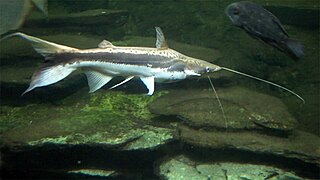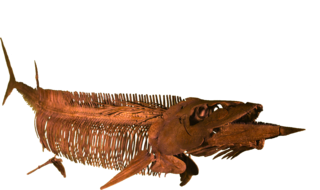
Bolodon is a genus of extinct mammal from the Lower Cretaceous of Europe and North America. It was a member of the extinct order of Multituberculata and belongs to the suborder Plagiaulacida and family Plagiaulacidae.

The lingcod or ling cod, also known as the buffalo cod or cultus cod, is a fish of the greenling family Hexagrammidae. It is the only extant member of the genus Ophiodon. A slightly larger, extinct species, Ophiodon ozymandias, is known from fossils from the Late Miocene of Southern California.

The snaggletooth shark, or fossil shark, is a species of weasel shark in the family Hemigaleidae, and the only extant member of the genus Hemipristis. It is found in the Indo-West Pacific, including the Red Sea, from southeast Africa to the Philippines, north to China, and south to Australia, at depths from 1 to 130 metres. This shark can be found near the bottom of the water column of coastal areas, but can be found at continental and insular shelves. Its length is up to 240 cm (7.87 ft). Despite being only vulnerable to extinction, this shark is very rarely seen.

The lesser spear-nosed bat is a bat species found in Bolivia, Brazil, Colombia, Ecuador, Guyana, Peru, Suriname and Venezuela.

Phyllostomus is a genus of leaf-nosed bat. It contains four described species.

The Majoidea are a superfamily of crabs which includes the various spider crabs.

Sorubim is a small genus of long-whiskered catfish native to tropical South America. A number of characteristics allows the differentiation of each species in the genus. Sorubim species are important food fish in South America and are highly significant to fisheries of some areas; however, harvests of these fish are not identified as much as other, more popular food fishes such as Colossoma, Arapaima, and Brachyplatystoma. Some species of this family are popular aquarium fish.

Podocarpus elongatus, the Breede River yellowwood, is a species of conifer in the family Podocarpaceae. In contrast to other yellowwood species of southern Africa, Podocarpus elongatus often resembles an enormous, round, multi-stemmed bush in its habit. The Breede River yellowwood is a protected tree in South Africa.

The Del Norte salamander is a species of salamander in the family Plethodontidae endemic to the United States in southwestern Oregon and northwestern California.

Saurodon is an extinct genus of ichthyodectiform fish from the Cretaceous.

Elongatoolithus is an oogenus of dinosaur eggs found in the Late Cretaceous formations of China and Mongolia. Like other elongatoolithids, they were laid by small theropods, and were cared for and incubated by their parents until hatching. They are often found in nests arranged in multiple layers of concentric rings. As its name suggests, Elongatoolithus was a highly elongated form of egg. It is historically significant for being among the first fossil eggs given a parataxonomic name.

Tenuidactylus elongatus, also known as the Yangihissar gecko or Kashghar thin-toed gecko, is a lizard species in the genus Tenuidactylus. Its type locality is Yangihissar. It is found in Turkestan, southern Mongolia, and China.

Prosoplus is a genus of longhorn beetles of the subfamily Lamiinae, containing the following species:

Sebastes elongatus, the greenstriped rockfish, striped rockfish, strawberry rockfish, poinsettas, reina or serena, is a species of marine ray-finned fish belonging to the subfamily Sebastinae, the rockfishes, part of the family Scorpaenidae. It is found in the northeastern Pacific Ocean.

Notoscopelus elongatus is a species of lanternfish in the family Myctophidae. It is endemic to the Mediterranean Sea where it is found in deep water habitats, rising to near the surface to feed at night and descending to great depths by day. It is a common species with no particular threats, and the International Union for Conservation of Nature has listed its conservation status as being of least concern.
Prosoplus atlanticus is a species of beetle in the family Cerambycidae. It was described by Stephan von Breuning in 1938.

Rhytiphora bankii is a species of beetle in the family Cerambycidae. It was first described by Johan Christian Fabricius in 1775, under the genus Lamia. It is known from Australia, the Philippines, Borneo, Java, Micronesia, New Guinea, Hawaii, Moluccas, Sumatra, Vietnam, and has been introduced into Japan. The Australian species of Prosoplus were synonymised with Rhytiphora in 2013.
Prosoplus sinuatofasciatus is a species of beetle in the family Cerambycidae. It was described by Blanchard in 1855.

Synechococcus elongatus is a unicellular cyanobacterium that has a rapid autotrophic growth comparable to yeast. Its ability to grow rapidly using sunlight has implications for biotechnological applications, especially when incorporating genetic modification.
Campocraspedon is a genus of ichneumonid wasp in the insect order Hymenoptera. It comprises six species.
















